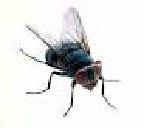Natural Solutions to Things That Bug You (52 page)
Read Natural Solutions to Things That Bug You Online
Authors: Myles Bader

Blacklegged deer tick

 This tick loves deer and is usually found in the East. It prefers white-tailed deer as its source of food and transmits Lyme disease. In the Midwest the same tick is called the bear tick. It is a very small tick and the nymph is about the size of a black pinhead. Because of the ticks size you will hardly know if you have been bitten. Males are black and females are reddish.
This tick loves deer and is usually found in the East. It prefers white-tailed deer as its source of food and transmits Lyme disease. In the Midwest the same tick is called the bear tick. It is a very small tick and the nymph is about the size of a black pinhead. Because of the ticks size you will hardly know if you have been bitten. Males are black and females are reddish.
Blacklegged Deer Tick will feed on a variety of hosts including deer and people. The eggs will hatch in the spring and the very tiny larvae feed primarily on white-footed mice or other small mammals. The following spring, the larvae will molt into pinhead-sized, brown nymphs that will feed on mice, larger warm-blooded animals and people.
In the fall, they molt into adults that feed primarily on deer, with the females laying eggs the following spring. Adults are reddish-brown and about 1/8-inch long. These ticks are found mostly in wooded areas along trails. The larvae and nymphs are active in the spring and early summer; adults may be active in both the spring and fall. The blacklegged deer tick can transmit Lyme disease and possibly ehrlichiosis to humans.
Lone star tick
The lone star tick is usually found in Illinois, although it can occasionally be found further north. The larvae, nymphs and adults are not fussy and will feed on a variety of warm-blooded hosts, including people. The larva is very small, just a little larger than the period at the end of this sentence. The nymph is the most common stage found on people and is about pinhead-sized.
The adults are about 1/8-inch long and brown. The adult female has a white spot in the middle of her back. The lone start tick is so similar in size it is sometimes misidentified by as the blacklegged deer tick. The lone star tick is more active from April through the end of July. Although it can transmit Rocky Mountain spotted fever, the lone star tick is not as likely to transmit the disease as the American dog tick.
This tick also may transmit tularemia and ehrlichiosis to humans. The lone star tick is not believed to transmit the bacteria that causes Lyme disease but may be associated with a bacteria species.
Rocky Mountain wood tick
Similar in appearance to the American dog tick and is usually found west of the Rocky Mountains. It transmits Rocky Mountain spotted fever, tularemia (rabbit fever), Colorado tick fever and tick paralysis.
Western black leg tick
This tick is found in the Western states and may be called the
“cowboy tick”.
It can transmit Lyme disease and is about the same size as the deer tick. It is reddish-brown and has black legs.
Winter tick
 The winter tick is a species that feeds on larger mammals like deer, cattle, horses and an occasional person. It is different from the hard ticks since the winter tick attaches to the host as a larva and remains attached throughout its life. Because of this the tick is rarely encountered by campers or hikers. However, hunters may find the winter tick in large numbers on deer carcasses.
The winter tick is a species that feeds on larger mammals like deer, cattle, horses and an occasional person. It is different from the hard ticks since the winter tick attaches to the host as a larva and remains attached throughout its life. Because of this the tick is rarely encountered by campers or hikers. However, hunters may find the winter tick in large numbers on deer carcasses.
The winter tick may carry diseases to large wild mammals; however, it is not known to transmit disease to humans. The best way to protect yourself against tick-borne illness is to avoid tick bites. This includes avoiding known tick-infested areas. However, if you live in or visit wooded areas or areas with tall grass and weeds, follow these precautions:
Wear protective clothing such as long-sleeved shirts, long trousers, boots or sturdy shoes and a head covering. (Ticks are easier to detect on light-colored clothing.) Tuck trouser cuffs in socks. Tape the area where pants and socks meet so ticks cannot crawl under clothing.
Apply natural insect repellent to clothes and exposed skin.
Walk in the center of trails so weeds do not brush against you. In camping areas, individuals who sit on the ground or disturb leaf litter on the forest floor may encounter ticks.
Check yourself, your children and other family members every two to three hours for ticks. Most ticks seldom attach quickly and rarely transmit disease organisms until they have been attached four or more hours.
If your pets spend time outdoors, check them for ticks, too.
If ticks are crawling on the outside of clothes, they can be removed with masking tape or duct tape.
A ring of tape can be made around the hand by leaving the sticky side out and attaching the two ends. Ticks will stick to the tape which can then be folded over and then placed in the trash.
Remove any tick promptly. The mouthparts of a tick are barbed and may remain embedded and lead to infection at the bite site if not removed promptly.
Do not burn the tick with a match or cover it with petroleum jelly or nail polish. Do not use bare hands to remove the tick because tick secretions may carry disease. The best way to remove a tick is to grasp it firmly with tweezers as close to the skin as possible and gently, but firmly, pull it straight out. Do not twist or jerk the tick. If tweezers are not available, grasp the tick with a piece of tissue or cloth or whatever can be used as a barrier between your fingers and the tick.
Ticks can be safely disposed of by placing them in a container of soapy water or alcohol, sticking them to tape or flushing them down the toilet. If you want to have the tick identified, put it in a small vial of alcohol.
Wash the bite area and your hands thoroughly with soap and water and apply an antiseptic to the bite site.
If you have an unexplained illness with fever, contact a physician. Be sure to tell the physician if you have been outdoors in areas where ticks were present or traveled to areas where tickborne diseases are common.
FLANNEL COAT YOUR YARD
If you think that you have a bad tick or flea problem in your yard, just take a piece of flannel with a string on it and pull it around the yard. Fleas and ticks are attracted to flannel and will jump on for the ride. Turn the cloth
over to check to see how many you have trapped. If there is a lot you will need to spray and disinfect the areas.
CHAPTER 10

FLIES
FLIES
GENERAL INFORMATION
 There are over 100,000 species of flies. They are disease spreaders and should be eradicated whenever possible. An adult female housefly is capable of producing up to 2,400 eggs in her lifetime. In hot weather flies can multiply in 2-3 weeks, especially if they have a good supply of fresh warm excrement from a family pet. If you ingest fly eggs they can cause a stomachache. Flies have 4,000 faceted eyes and have ultra-sensitive hairs that can detect even the slightest change in air currents. Flies take off somewhat backwards and if you aim a flyswatter toward their back you will kill more flies.
There are over 100,000 species of flies. They are disease spreaders and should be eradicated whenever possible. An adult female housefly is capable of producing up to 2,400 eggs in her lifetime. In hot weather flies can multiply in 2-3 weeks, especially if they have a good supply of fresh warm excrement from a family pet. If you ingest fly eggs they can cause a stomachache. Flies have 4,000 faceted eyes and have ultra-sensitive hairs that can detect even the slightest change in air currents. Flies take off somewhat backwards and if you aim a flyswatter toward their back you will kill more flies.
When you see fly specs, the dark specs are excrement and the light specs are regurgitated food and saliva. A horsefly can actually bite through leather and can inflict a painful bite in humans. The stable fly has a proboscis like a hypodermic needle and draws blood, usually from a person’s ankle, socks or no socks. Best to wear boots around stables!
Flies have three body parts: head, thorax, abdomen and one pair of fully developed wings. Their hind wings are reduced to small knob-like structures used to maintain equilibrium. Adult mouth parts are sponging, lapping, or piercing and all adults look like flies, but some may have a metallic color (blue bottle fly). Their antennae may be difficult to see.
Males and females may be hard to distinguish. Females are usually larger and can extend the tip of the abdomen to form an ovipositor, which is used to lay eggs. Sometimes males have enlarged eyes, which meet on top of the head. Flies have four distinct morphological stages; egg, larva (maggot), pupa and adult. After hatching from the egg, larvae molt twice as they grow and the molting of maggots is difficult to see.